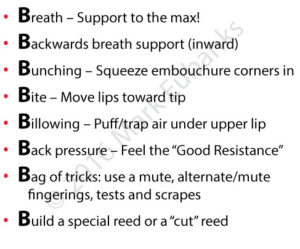Introduction
The first thing that we hear in a bassoon tone is the attack quality, whether it is clear or distorted in some fashion. Following that, does the sustained tone remain clear, distorted, split, or spitty? Does the tone have a pleasing quality or is it dull, out of tune, harsh, forced, or a buzz bomb? These problems are usually related to the reed tuning and adjustment issues we all face. But these elements can be exacerbated by tone production variables as noted below. Tone quality is also a function of the bassoon, bocal, and believe it or not, hand position. For instance, if the extreme finger tip makes contact with the five open tone holes, the tone quality is more focused than if the fleshy part of the finger makes contact. The extreme finger tip can only make contact if the fingers are curved. The fleshy part of the finger is more common and as a result of playing with flat fingers. The worst finger technique is the collapsed first knuckle. (See the bassoonist in the scrolling slider on the front page of this website!) Why is this bad? After the tip of the finger makes contact with the tone hole changing the note, there is a secondary movement of the collapsed first knuckle which slows down the finger technique. With either the curved finger or flat finger technique, there should be no secondary movement of the knuckles.
Playing in Tune
Playing in tune is usually also associated with a beautiful, singing bassoon tone and pitch flexibility. But some are not aware of what it takes to really play in tune. Read more about playing in tune.
Embouchure

Chinless embouchure
There are several basic types of embouchures
- The smile

The smile
- The frown
- The circle
- Dropped jaw (chinless embouchure)
Each type has it’s advantages and disadvantages. Each type can be fixed or flexible. The non-fixed smile or the frown the jaws will be closer together but can quickly morph to the circle with the corners of the mouth moving inward. This is the primary mechanism by which we drop into a lower register.
- Underbite
- Overbite
Common Embouchure Problems
- Lips pulled tightly over teeth.
- Incorrect lip roll in/out for register.
- Jaw too closed.
- Jaw too closed/open for register.
- Incorrect lip position on blade for register.
Tone Quality
Air Speed/Air Pressure
Oral Cavity/Vowel Shape
- Fixed vowel shape.
- Incorrect vowel for register.
Breath Support
- Inwardly locked and fixed abdominal muscles.
- Shallow breathing/incomplete breath.
- Incorrect push point for register.
- Incorrect air speed for register.
- Incorrect balance of air speed and vowel shape.
Articulation
Tonal Distortion
Double Tonguing
Pianissimo Playing
Tone Production Exercises
Finger Dexterity Exercises

